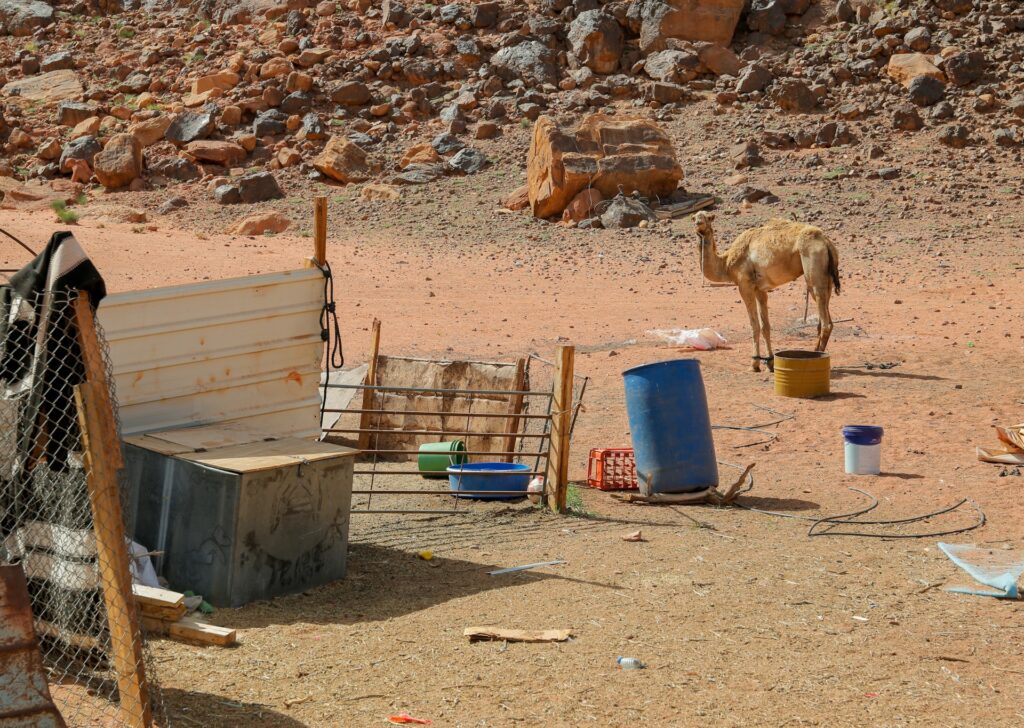Wadi Rum, Jordan – The sprawling desert valley has for centuries been home to nomadic people who traditionally made a living herding goats, sheep and camels, as well as hunting.
But with climate change affecting their livelihood, the Bedouins here in the southern part of the country have had to develop the area as a tourist site.
Salaha al-Zalabeih, 89, has been living in Wadi Rum all her life and has seen the area change before her eyes. The UNESCO World Heritage site has become renowned for being one of the country’s most popular destinations for visitors.
“My family used make a living through herding sheep and camels. But as [it] started raining less, it became difficult to keep the animals and sustain a living. We had to move to the village and sell our animals,” al-Zalabeih told Al Jazeera.
The al-Zalabeih family gives guided tours and runs a camp for travellers.
Salaha al-Zalabeih, 89, and her family have lived for generations in Wadi Rum, Jordan [Bayan Abu Ta’ema/Al Jazeera]
Effects of climate change
According to the K?ppen-Geiger climate classification, which uses colours and shades to categorise the world into climate zones based on criteria such as temperature, Jordan will in the future be a “red” country.
This indicates it will face high temperatures and severe droughts, said Laith al-Dasouqi, an energy and climate consultant.
Al-Dasouqi, who specialises in renewable energy engineering and management, explained that Wadi Rum faces increased temperatures, water scarcity, desertification and a higher frequency of extreme weather events such as a large flood in November 2014.
Some areas in Wadi Rum face moderate to high potential of flooding, which could have dire consequences for residents, al-Dasouqi said, including disruptions in livelihood, affecting the local tourism industry, and causingsoil erosion that affects vegetation cover.
The groundwater in Wadi Rum is mainly considered non-renewable. According to observations from the BGR Water Yearbook, the groundwater level has been declining since 1996 at a fixed rate of about 1.2 metres per year.
“Higher temperatures will lead to consuming more groundwater, and this will affect not just the people who live in Wadi Rum, but the whole country,” al-Dasouqi said.
Salaha al-Zalabeih and her family live in the Wadi Rum village [Bayan Abu Ta’ema/Al Jazeera]
Increase in extreme weather
Although there has been an increase in flood frequency in Jordan, this has not meant that people have had access to more water. If anything, al-Dasouqi explained, it is ruining the soil.
The primary source of water in Jordan, including surface and groundwater, is rain, he said.
“Due to the low rainfall and high evaporation rates, it is challenging to sustain an adequate water supply. Wadi Rum receives very little rainfall per year, and in some areas the rainfall is almost zero,” he added.
According to the Standardized Precipitation Index, a statistical indicator, Jordan is experiencing a higher occurrence of drought.
“Overall, climate change can have significant impacts on the living conditions of people in Wadi Rum, affecting their access to water, food and livestock, as well as safe living conditions,” al-Dasouqi said.
Hala Murad, head of the Dibeen Association for Environmental Development, said spending money on development projects is an important tool to reduce the consequences of climate change.
“Investing in these projects [is important] for the local population in Wadi Rum and to address the danger of torrential rains, as well as creating a surrounding infrastructure that prevents the formation of local torrents. That will be important,” she told Al Jazeera.
One day at a time
Despite the changes in climate, al-Zalabeih and her family say they are taking it day by day and have seen an improvement in the quality of life during the past decades.
“Life is better now than when I was young. We only had camels and no cars. As the village has grown, we have also gotten schools for the kids,” she said.
She did not have the opportunity to go to school herself and said she is grateful “that it has gotten easier and better for the generations coming after me”.
Al-Zalabeih’s grandson, Salman, works with tourists year round [Bayan Abu Ta’ema/Al Jazeera]
Al-Zalabeih’s grandson, Salman, also lives in the village, working with tourists year round.
“We live day by day and it is hard to say how climate change will affect the area in the future. As of now, we are grateful for the rain we had this winter, and being able to sustain ourselves through tourism,” he said.
Although most tourists visiting the area are respectful, not all treat nature in the best way, according to Salman.
“We see that some tourists bring their own cars, which is dangerous when you do not know the area,” he said, explaining this often means vehicles ruining local vegetation.
He also said some tourists throw rubbish without taking nature’s best interests into consideration.
Salman said the community has noticed differences in temperatures over the years, as winters in Wadi Rum have turned colder and the summers warmer. The winters have accordingly seen an increase in rainfall, something Salman sees as a mixed blessing.
“It helps to give water to the animals in the desert, but when it gets colder it also means we need to use more electricity. It also affects the animals negatively if it gets too cold, as they might not survive the low temperatures,” he said.
Jordan, the second most water-scarce country in the world, is adapting to the consequences of climate change.

